
Sustainability and sustainable development are extremely topical issues for modern society. The concept of sustainability was brought to the attention of humanity during the 20th century, when the increasing development of some countries originated environmental concerns and stimulated humans to gain a deeper understanding of natural resources, their dynamics and impact of overexploitation.
The purpose of this essay is to introduce the concepts of sustainability and sustainable development and review their main implications. I will first describe how the capability of Earth and human systems to adapt to - and sustain - societal developments became a global concern. Then, I will provide a definition of sustainable development and I will finally discuss the main concerns for the future.
To get a quick start, it may be useful to look at this video. You will get a first perception of what sustainability is, but the video will left you with many open questions, including: "and then? What should I do?".
In order to better understand the importance of sustainability and its role for the progress of humanity it is useful to look back at when environmental preservation and restoration became relevant issues for humanity.
Unsustainable impacts of human development are part of the history of humanity since prehistoric times. Indeed, ancient civilisations experienced local problems related to societal evolution. A relevant example is ancient Athens where efficient systems were built to supply water and to manage wastes. To understand how sustainability emerged as a global concern we have to go back to the 18th century. At that time, the industrial revolution, that took place between the 18th and the 19th century, marked a tremendous shift in the societal assets and standards of living of humanity. It also induced an unprecedented rise in the rate of population growth. Economic growth spread to all regions of the world during the twentieth century, when world gross domestic product (GDP) per capita quintupled.
The expansion of the use of machines in the newly introduced manufacturing processes highlighted the key role that energy - initially made available through steam power - plays in the industrial development and therefore on local and global economy (see Figure 1). Energy is produced from natural resources by means of conventional, alternative and renewable resources. Energy production impacts on the environment. In fact, the industrial revolution and the associated production of energy, mainly through coal consumption, caused increasing and unprecedented levels of smoke pollution in the atmosphere. Furthermore, after 1900 the large volume of industrial discharges added to the growing load of untreated human waste, therefore causing increasing pollution of rivers and lakes. Up to the beginning of the 20th centuries water flowing in most of the European large rivers was still drinkable. After a few decades water quality was heavily deteriorated, thus causing anoxic conditions in some cases and heavy environmental impact.
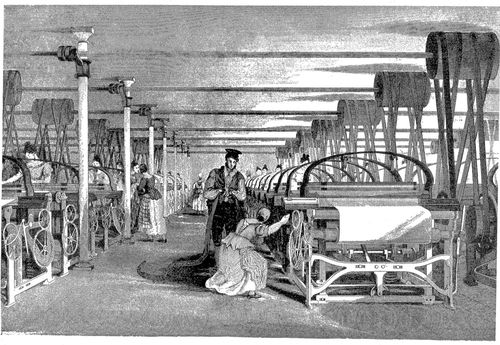
Figure 1. A Roberts loom in a weaving shed in 1835. Textiles were the leading industry of the Industrial Revolution and mechanized factories, powered by a central water wheel or steam engine, were the new workplace. By Illustrator T. Allom - History of the cotton manufacture in Great Britain by Sir Edward Baines. Public Domain, https://commons.wikimedia.org/w/index.php?curid=9430141
The list of the unforeseen and seemingly unsustainable impacts of societal development is long. To mention only a few:
- The development of intensive agriculture implied a marked increase of water demands for irrigation and caused pollution of surface water and groundwater due to fertilisation, therefore originating the need for efficient water resources management strategies. Note that this impact is not directly connected to energy production. It is rather related to the increasing need of water for food, which is another consequence of societal development.
- The construction of dams and river barrages for producing energy and delivering water for irrigation and civil use induced extensive deprivation of river flows, therefore causing concerns for river ecology and morphology, groundwater replenishment, and so on. These concerns originated the concept of environmental flow, which is defined as the quantity, timing, and quality of water flows required to sustain freshwater and estuarine ecosystems and the human livelihoods and well being that depend on them.
- The increased demands for energy, which is today mainly produced by burning fossil fuels, is originating concerns related to the sustainability of energy production.
- The concentration of carbon dioxide (CO2) in the atmosphere is markedly increased during the 20th century. Such increase may be due to humans, in particular to burning fossil fuels. It may have caused the global warming that was observed since the mid of the 20th century, which is in turn inducing other forms of climate change.
The above unintended consequences of the industrial revolution and societal development pointed out, for the first time in our history, that human development may not be sustainable by the Earth system. The awareness of the above threats stimulated the development of a collective consciousness of the necessity to better understand and protect the environment in its broadest sense.
The awareness that human development may be unsustainable at the global level stimulated politicians and policy makers to promote international forums to discuss potential ways forward. An example of a first governmental declaration in favour of sustainability is the European Water Charter promulgated by the Council of Europe in 1968. The main points of the Charter are:
- There is no life without water. It is a treasure indispensable to all human activity.
- Fresh water resources are not inexhaustible. It is essential to conserve, control, and wherever possible, to increase them.
- To pollute water is to harm man and other living creatures which are dependent on water.
- The quality of water must be maintained at levels suitable for the use to be made of it and, in particular, must meet appropriate public health standards.
- When used water is returned to a common source it must not impair the further uses, both public and private, to which the common source will be put.
- The maintenance of an adequate vegetation cover, preferably forest land, is imperative for the conservation of water resources.
- Water resources must be assessed.
- The wise husbandry of water resources must be planned by the appropriate authorities.
- Conservation of water calls for intensified scientific research, training of specialists and public information services.
- Water is a common heritage, the value of which must be recognised by all. Everyone has the duty to use water carefully and economically.
- The management of water resources should be based on their natural basins rather than on political and administrative boundaries.
- Water knows no frontiers: as a common resource it demands international co-operation.
The Charter concluded by stating that "International problems arising from the use of water should be settled by mutual agreement between the States concerned, to conserve the quality and quantity of water".
It is interesting to notice that water resources management was the first impact of societal development that concerned policy makers. It also relevant the last sentence of the charter, that points out the need for international agreements for resolving the concerns related to sustainability. In fact, initially sustainability was perceived as a local problem and therefore solutions were proposed at the local level. The reason was that the impact of unsustainable exploitation of environmental resources initially emerged in the form of local problems mainly related to air and water pollution, and water scarcity. It is also interesting to look at the second item of the charter: it is recognized that water is not inexhaustible therefore posing the basis for recognizing water as an economic good. Finally, the statement "Water resources must be assessed" is extremely modern and clearly points out that the understanding by humanity of the status of water resources is still limited and thus there is the need to reinforce monitoring programs.
It was only in more recent times that policy makers perceived sustainability as a global problem, therefore recognising that global strategies are needed for mitigation of impacts and adaptation. In the late 20th century, the spatial scale of environmental problems increased progressively thus assuming a global extension. In 1973 and 1979 humanity experienced global energy crises that demonstrated how global community had become dependent on non-renewable energy resources.
The increasing awareness of the global dimension of environmental problems led the United Nations General Assembly to convene in 1972 the United Nations Conference on the Human Environment. The conference was held in Stockholm as Sweden first suggested to the United Nations in 1968 the call for a UN conference to focus on human interactions with the environment. At the conference it became clear that environmental protection and societal development have significant political implications, as they are directly linked with human rights. In fact, environmental human rights can be derived from other human rights like the right to life, the right to health, the right to private family life and the right to property (among many others). The onset of various environmental issues, especially those related to climate change, has created potential conflicts between different human rights. Human rights ultimately require a working ecosystem and healthy environment, but the granting of certain rights to individuals may damage the environment itself.
Different views and divisions between developed and developing countries began to emerge at the Stockholm conference, which nevertheless produced a declaration containing 26 principles concerning the environment and development (the Stockholm declaration), an action plan with 109 recommendations, and a resolution. The Stockholm declaration pointed out that "Natural resources must be safeguarded" but "Development is needed to improve the environment"; "Environment policy must not hamper development", and "Integrated development planning is needed". It may be argued that the Stockholm conference had a real impact on the environmental policies of the European Community (that later became the European Union). For example, in 1973, the EU created the Environmental and Consumer Protection Directorate, and developed the first Environmental Action Program.
During the decades after the Stockholm conference global environmental challenges increased. Particularly, the problem of how to reduce poverty in low-income countries without exacerbating the global and local environmental problems remained unresolved. No country was willing to give up an economic development based on growth, but several additional environmental threats emerged besides those that were listed above. To name only a few of the concerns that were brought to the attention of humanity during the 1980s and 1990 we may cite:
- acid rain;
- deforestation;
- desertification;
- the reduction of the ozone layer;
- to early signs of climate change.
Therefore, a tangible need emerged for a developmental concept that would allow reconciling economic development with environmental protection with a very broad vision encompassing the whole environment. Water and air were no more the only concern, and the attention shifted to the spatial scale of the whole Earth system.
A significant impulse to international cooperation for environment was given by the end of the Cold War, which was a period of geopolitical tension between the Soviet Union with its satellite states (the Eastern Bloc), and the United States with its allies (the Western Bloc) after World War II. The Cold War was symbolically ended by the revolutions of 1989, the demolition of the Berlin Wall and the declaration of the President of the United States George H.W. Bush at the Malta Summit. The revolutions of 1989 and subsequent liberalization of economy in many parts of the world resulted in a significant expansion of interconnectedness and globalization, implying a profound change of the global economy and a corresponding exacerbation of environmental concerns.
Due to issues relating to sustainability being too big for individual member states to handle, in 1992 the The United Nations Conference on Environment and Development (UNCED), also known as the Rio de Janeiro Earth Summit, the Rio Summit, the Rio Conference, and the Earth Summit was convened by the United Nations in Rio de Janeiro from 3 to 14 June. It was attended by more than 100 heads of states. It marked a significant step forward in terms of widespread political attention to environment.
Another significant step was marked in 2002 by The World Summit on Sustainable Development (WSSD), or the ONG Earth Summit 2002, which took place in Johannesburg, South Africa.
In 2012, a second United Nations Conference on Sustainable Development was also held again in Rio de Janeiro 20 years after UNCED. It is commonly referred to as the Rio+20 or Rio Earth Summit 2012.
The issues addressed in the above United Nations Earth summits included:
- systematic scrutiny of patterns of production — particularly the production of toxic components, such as lead in gasoline, or poisonous waste including radioactive chemicals;
- alternative sources of energy to replace the use of fossil fuels which delegates linked to global climate change;
- new reliance on public transportation systems in order to reduce vehicle emissions, congestion in cities and the health problems caused by polluted air and smoke;
- the growing usage and limited supply of water.
An important achievement of the Earth Summit of 1992 and 2012 was an agreement on the Climate Change Convention which in turn led to the Kyoto Protocol and the Paris Agreement. Another agreement was to "not to carry out any activities on the lands of indigenous peoples that would cause environmental degradation or that would be culturally inappropriate".
The Earth Summit produced the following documents:
In particular, Agenda 21 is a non-binding action plan of the United Nations to ensure sustainability. It is an action agenda for the UN, other multilateral organizations, and individual governments around the world that can be executed at local, national, and global levels. The "21" in Agenda 21 refers to the 21st century. One major objective of the agenda 21 is that every local government should draw its own local Agenda 21.
As noted above, the increasing relevance and visibility of sustainability brought environmental concerns to the attention of politicians wordlwide, who progressively included environmental policy as a relevant issue in their agenda and programmes. Then, the green politics became influential in contemporary society. Green politics (also known as ecopolitics) is a political ideology that aims to create an environmentally friendly society rooted in nonviolence, social justice and grassroots democracy. It began taking shape in the western world in the 1970s and since then green parties have developed and established themselves in many countries around the globe and have achieved some electoral success. A relevant example of political attention on environmental concerns and scientific research was given by the 2000 presidential electoral campaign of Al Gore, who later was awarded with the Nobel Prize (together with the Intergovernmental Panel on Climate Change) in 2007.
During the course of the above conferences and societal developments the main focus of environmentalists progressively shifted towards climate change, which was perceived as a dominant threat. As a result, increasing support was provided to climate science while lower priority was given to other environmentally relevant scientific disciplines, like water science. The above progressive shift induced vivid debates and criticism in the scientific community. In view also of the relevant uncertainty associated to climate science, and the plurality of interpretation regarding the attribution of recent climate change, the debate on anthropogenic global warming and change became more and more controversial (see, for instance, the global warming controversy). The above controversy, together with the fact that there is still limited technical guidance to climate change mitigation and adaptation, is decreasing the confidence by the public and policy makers in scientific objectivity in reference to climate change and environmental problems.
Another implication of the above development is that engineering has been often identified as a main driver of environmental degradation. The green politics often identified large scale infrastructures, like for instance artificial reservoirs and river barrages for water resources management, as relevant causes of environmental degradation. Therefore, we observe today a progressive community distrust of engineering and technology, while increasing interest is addressed to the so-called "green solutions" or "nature-based solutions".
As a result, there is an increasing consensus towards "no action", which does not take into account that natural environment needs to be protected and preserved, as its natural evolution is often not compatible with the need of reducing natural hazards and natural systems breakdowns. Today it is increasingly difficult to recognize what is "natural" from what is "human induced" and to distinguish positive from negative human impacts basing on scientific evidence. We assist to a non-constructive tendency to assume that any extreme event is artificially induced, with the implicit and wrong assumption that natural events would be smooth and positive if humans were not there. Human actions are associated to engineering, which explains the public distrust in a discipline that we need to evolve and profit from if we want to build a successful environmental policy.
In fact, the distrust in engineering is a relevant problem in the context of sustainability and environmental protection, because engineering is an essential science for environmental protection and recovery. As the Stockholm conference pointed out, "Development is needed to improve the environment". While nature-based solutions and "no-action" may be a satisfactory solution in some cases, they cannot be an universally valid approach towards sustainability. Neglecting the value and essential role of infrastructures for societal development and neglecting the role of engineering undermines the opportunity to identify effective solutions. There are situation where infrastructures are the only way forward to sustainability. In such cases, neglecting these solutions means that no way forward is finally identified. These concepts will be further discussed in section 3.1 below.
Sustainability was first defined in ecology as the property of biological systems to remain diverse and productive indefinitely. Diversity is an essential requirement for a system to be flexible and able to adapt, which in turn is a necessary condition to survive to shocks. An example are healthy forests that proved to be able to survive for very long time in good conditions notwithstanding the impact of several environmental changes. Another example is the ocean. The concept of sustainability can be extended to any environmental, political and socio-economical system. Today, there is increasing evidence that environmental systems are strictly connected with human systems like political and economical ones, and therefore there is increasing awareness that sustainability of the whole earth system is linked with a two way interaction with human society.
The extension of the concept of sustainability to societal development dates back to 1980s. At that time, it was a common belief that "societal development" - that is strictly related to engineering and economics - and "sustainability" - that is strictly related to environment and natural resources - were antithetic. Therefore, engineering and global economy were identified as the enemies of environmental protection and restoration. Development was identified as the main cause of environmental degradation, increased risk of natural hazards and disparity in the human systems. Political ideas and forces promoting progress and evolution of society were in different ways opposed or criticised by those promoting equality, diversity and environmental care within a democratic and participatory approach. Such a view led to political and scientific controversies, some of which are still debated today, which undermine the identification of real problems, priorities and ways forward. While, on the one hand, controversy may favor the confrontation of different opinions and therefore a comprehensive approach to a problem, on the other hand global economy and the environment are very complex systems and therefore their comprehension would benefit by a cooperative approach and a constructive debate.
Actually, starting from the understanding that sustainability of contemporary society is strictly connected to societal development, the idea came forward to coin a new term and concept to emphasise that "sustainability" and "development" are not antithetic, bur rather strictly coupled. The 1980 World Conservation Strategy of the International Union for the Conservation of Nature was the first report that included a very brief chapter on a concept called "sustainable development". It focused on global structural changes and was not widely read.
In December 1983, the Secretary-General of the United Nations (UN), Javier Pérez de Cuéllar, who repeatedly advocated the use of the UN for keeping the peace and serving as a forum for negotiations, asked the Prime Minister of Norway, Gro Harlem Brundtland, to create an organization independent of the UN to focus on environmental and developmental problems and solutions. This new organization was the Brundtland Commission, or more formally, the World Commission on Environment and Development (WCED). The Brundtland Commission was first headed by Gro Harlem Brundtland as Chairman and Mansour Khalid as Vice-Chairman. The organization aimed to create a united international community with shared sustainability goals by identifying sustainability problems worldwide, raising awareness about them, and suggesting the implementation of solutions. In 1987, the Brundtland Commission published the first volume of “Our Common Future,” the organization’s main report. “Our Common Future” strongly influenced the 1992 Earth Summit in Rio de Janeiro.
The Brundtland Commission draws upon several notions in its definition of sustainable development, which is the most frequently cited definition of the concept to date. The definition reads as:
"Sustainable development is development that meets the needs of the present without compromising the ability of future generations to meet their own needs".
It contains two key concepts:
- the concept of "needs", in particular the essential needs of the world's poor, to which overriding priority should be given;
- the idea of limitations imposed by the state of technology and social organization on the environment's ability to meet present and future needs.
A key element in the definition is the unity of environment and development.
Since then, there have been many alternative and extensions to the basic definition. The quotes below provide alternative views on sustainable development and sustainability.
- "A process of change in which the exploitation of resources, the direction of investments, the orientation of technological development and institutional change are all in harmony and enhance both current and future potential to meet human needs and aspirations." (The World Commission on Environment and Development).
- "Sustainable development is a dynamic process which enables people to realise their potential and improve their quality of life in ways which simultaneously protect and enhance the earth's life support systems." (Forum for the Future).
- "In essence sustainable development is about five key principles: quality of life; fairness and equity; participation and partnership; care for our environment and respect for ecological constraints - recognising there are 'environmental limits'; and thought for the future and the precautionary principle." (From Making London Work by Forum for the Future's Sustainable Wealth London project).
- "The environment must be protected… to preserve essential ecosystem functions and to provide for the wellbeing of future generations; environmental and economic policy must be integrated; the goal of policy should be an improvement in the overall quality of life, not just income growth; poverty must be ended and resources distributed more equally; and all sections of society must be involved in decision making." (The Real World Coalition 1996, a definition based on the work of the World Commission on Environment and Development).
- "We cannot just add sustainable development to our current list of things to do but must learn to integrate the concepts into everything that we do." (The Dorset Education for Sustainability Network).
- "A sustainable future is one in which a healthy environment, economic prosperity and social justice are pursued simultaneously to ensure the well-being and quality of life of present and future generations. Education is crucial to attaining that future." (Learning for a Sustainable Future - Teacher Centre).
- "The first and perhaps most difficult problem, one that seldom gets addressed, is the time frame…Is a sustainable society one that endures for a decade, a human lifetime, or a thousand years?" (The shaky ground of Sustainable Development Donald Worster in Global Ecology 1993).
In 2005, the World Summit of the United Nations identified millenium development goals. This view developed by the World Summit has been expressed by a graphical representation by using three overlapping ellipses indicating three pillars of sustainability:
- economic development;
- social development;
- and environmental protection.
The key concept is that the pillars have been recognized as not mutually exclusive but rather mutually reinforcing. In fact, the three pillars are interdependent, and in the long run none can exist without the others (see Figure 2).
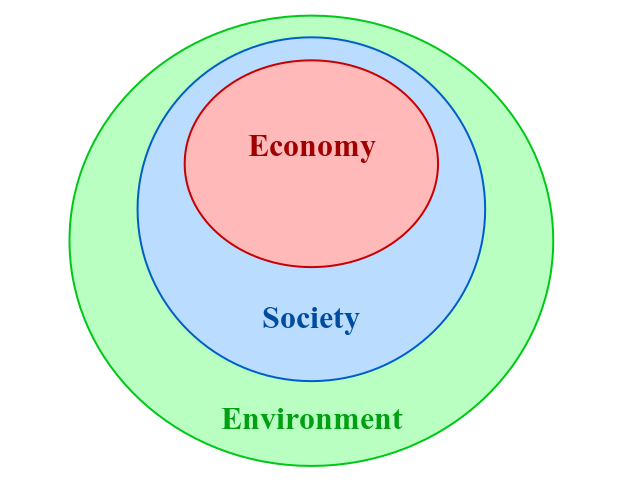
Figure 2. The three pillars of sustainability. Note that economy and society are constrained by environmental limits. By KTucker - Own work, CC BY-SA 3.0, https://commons.wikimedia.org/w/index.php?curid=17030898
The intersection among the three pillars is shown in Figure 3. The intersection between social and environmental pillars identifies the bearable strategies; the intersection between social and economics pillars identifies the equitable strategies, while the intersection between environment and economic pillars corresponds to viable strategies. Finally, the intersection between bearable, equitable and viable strategies identifies sustainable ways forward.
Therefore, the World Summit set the conceptual basis for reconciling sustainability with development. But the key question still remains open: how to identify that intersection between social, environmental and economic drivers? Clearly, we need to fully understand the dynamics of these drivers and we need innovative technologies to put solutions into practice.
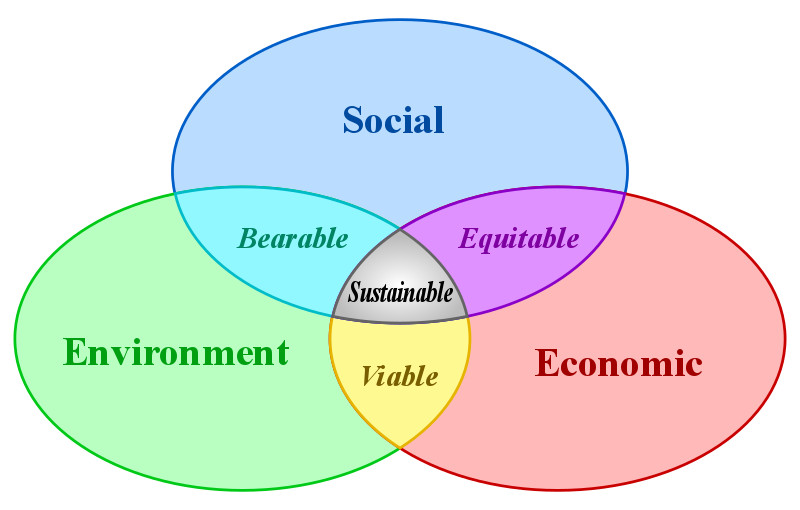
Figure 3. The three pillars of sustainability and their intersection. By original: Johann Dréo (talk · contribs)translation: Pro bug catcher (talk · contribs) - Own workInspired from Developpement durable.jpgTranslated from Developpement durable.svg, CC BY-SA 3.0, https://commons.wikimedia.org/w/index.php?curid=1587372
In fact, integral elements of sustainability are research, innovation, education, technological transfer and policy making. An example of policy towards sustainability is the European environmental research and innovation policy, which aims at defining and implementing a transformative agenda to greening the economy and the society as a whole so to make them sustainable.
Sustainability is closely connected to resilience of the related systems. Resilience was first defined in ecology as the capacity of an ecosystem to absorb disturbance and still retain its basic structure and viability. In the context of sustainability of environment, economic and society, resilience implies the need to manage interactions between human-constructed systems and natural ecosystems in a sustainable way. Resilience-thinking addresses how much systems can withstand the human impact while still delivering, to the current and future generations, their needed services.
The concept of sustainable development is subject to criticism, as on the one hand the whole Earth system, even in natural conditions, is not sustainable, as the history of other planets like Mars clearly shows. There is increasing evidence that Mars was once hosting water and maybe some forms of life, but the evolution of the planet caused the loss of water. On the other hand, human actions may help to achieve sustainability, through the management of the natural evolution of the Earth system. The human management of water resources, through the work of engineers, is a clear example where the human intervention may support the conservation of ecosystem and may shape the evolution of the landscape in a more sustainable manner. The concept of sustainability should be linked to the need of making the best possible use of Earth resources, including water, energy and food, with the awareness that future evolution and research innovation may be unpredictable, and the awareness that the processes governing the Earth system are affected by intrinsic uncertainty (think, for instance, at the impact that a planetary collision may have).
The United Nations have proposed in 2015 the sustainable development goals included in the 2030 agenda (see Figure 4) to end poverty, protect the planet and ensure prosperity for all as part of a new sustainable development agenda. Each goal has specific targets to be achieved over the next 15 years. For the goals to be reached, everyone needs to do their part: governments, the private sector, civil society and people like us. A nice introduction to sustainable development goals is given by this video.
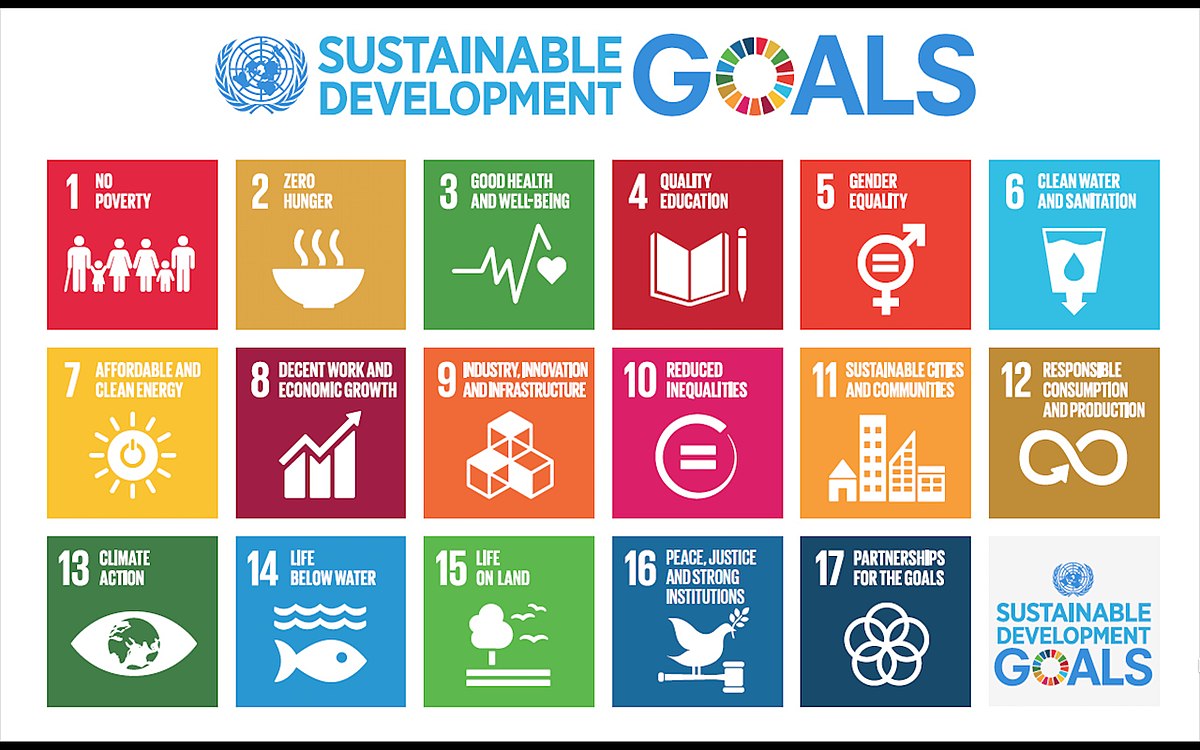
Figure 4. The Sustainable Development Goals, adopted on 25 September 2015 as a part of the 2030 Agenda. By MariaGershuni - Own work, Public Domain, https://commons.wikimedia.org/w/index.php?curid=52672594
As indicated earlier, research, innovation, education, technological transfer and policy making play a fundamental role to devise trajectories to sustainability. Research is needed to reach a better understanding of how global economy and the Earth system work. Research necessarily needs to be multidisciplinary and interdisciplinary (or - better - transdisciplinary, according to the definition provided in this blog). Innovation implies the use of the best technologies to make sure that development is really sustainable.
It is still not clear what is the role of each scientific discipline and what is the role of engineering to reach sustainable development goals. It is not yet clear how scientific multidisciplinarity, interdisciplinarity and transdisciplinarity should be better achieved. Scientific controversy, also due to the relevant political implications of sustainable development, instead of constructively leading to agreed solutions, often leads to sterile debates, alarmism and populism, therefore undermining public awareness and problem solving. Scientific publications often reduce to generic calls for interdisciplinary actions. Sometimes researches generically attribute the responsibility of environmental degradation to engineering and infrastructures, without identifying suitable ways forward.
Interactions and feedbacks among the main causes of the progressive environmental degradation are not yet explored and, consequently, there is no unanimous consensus on the most appropriate mitigation and remediation strategies. We urgently need to define the role of scientific research and engineering, to develop technical guidelines making the best use of innovation to get to target. Stakeholders involvement may provide a valuable support to identify the best integration of human knowledge by profiting from experience.
The role of engineering is essential for improving our understanding of environmental processes and developing technical guidelines (see Section 2.1 above). Engineering is the application of knowledge, typically in the form of science, mathematics, and empirical evidence, to the innovation, design, construction, operation and maintenance of structures, machines, materials, devices, systems, processes, and organizations. Therefore, engineering is precisely what humans need to apply the concepts and knowledge gained from scientific research on sustainability to devise solutions to global problems. Engineers are in many countries the only professionals that are allowed to carry out certain types of assessments in the industrial and civil sector, design relevant structures and infrastructures for water supply, water sanitation, wastewater treatment, waste disposal, land protection and environmental recovery in general. Moreover, research in civil and environmental engineering is essential to support environmental policy (see Section 2.1 above).
Environment and sustainability are new concerns for humanity, that need to be addressed by making an efficient and objective synthesis of human knowledge. There must be no room for instrumental interpretations and preconceptions. Humanity only needs to make the best use of research and assessments to promote the collective and transdisciplinary work of scientist, technicians and policy makers.
The imperative necessity to identify and design solutions for sustainability calls for a systematic approach to cope with the impacts of human activities. Mitigation, adaptation and resilience are instrumental to secure resources and opportunities for the future generations but it is necessary to identify priorities and global technical solutions. Actually, while the importance of sustainability is widely recognized we still lack a coherent picture of technical strategies to be designed in the context of engineering. In order to conceive and design a solution engineers usually refer to a context, or a "system", which needs to be identified and fully defined. Defining a system means to identify its domain, or "control volume", its forcings, constraints, boundary conditions and underlying physical and thermodynamic laws. To identify the systems that are potentially unsustainable in the context of the global Earth and societal setting we need to set priorities. Is the priority the climate system rather than the chain of energy production or the global water system? All of these systems are interconnected: links and feedbacks need to be considered in any case, but what is the priority? Is it climate, with water being a component of the climate system, or is it water, with climate being a driver of the related system?
There are two approaches of addressing the prioritization of risk management measures (Figure 5). The ‘top-down’ approach is designed to represent the main processes causing unsustainability and its consequences. In the case of climate impacts (Figure 5), the ‘top-down’ approach starts at the global scale and cascades information from emission scenarios of future societies to simulated climates using global and regional climate models, to runoff using hydrological models, to inundations using hydrodynamic models, and to damage costs using economic models. The top-down approach is motivated by an economic paradigm. Hence, risk is defined from an economic perspective, specifying hazard as the occurrence probability of a flood (or drought) event, vulnerability as the damage cost in monetary terms, and (economic) risk as the product of the two. This leads to an optimization problem that aims at identifying the most economic management strategy.
The ‘top-down’ approach is the most widely used approach for impact assessments, mitigation and adaptation. It is sometimes termed the ‘predict-then-act’ method as projected scenarios are the starting point and the main emphasis (Dessai and Hulme 2004). The entire cascade of inferences is rigorously model based. The appeal of the top-down approach is that it is conceptually straightforward and elegant as it mimics what is considered the main process cascade that leads to unsustainability.
The ‘bottom–up’ approach (Figure 5) starts at the local scale of individuals, households, and communities and explores the factors and conditions that enable successful coping with current challenges (Wilby and Dessai 2010). It gives the great opportunity to identify and resolve current problems, for instance lack of water, natural and human induced hazards. One starts from the actual necessity, instead of relying on future projections and feelings. The bottom-up approach is motivated by a social paradigm. The main goal is not to find the most convenient management strategy but to ensure the well-being of people by reducing vulnerability and enhancing resilience (the ability to recover after an event). It does not take climate projections as a starting point but the vulnerability and resilience of the risk-related system itself. It is sometimes termed the ‘assess-risk-of-policy’ method as it explores alternative policies first. Although the top-down approach is currently more popular, realization of the importance of the bottom-up approach is emerging: “Society will even benefit much more from a greater understanding of the vulnerability of climate-influenced decisions to large irreducible uncertainties than it will from extremely expensive attempts to increase the accuracy and precision of climate predictions. An alternative approach to the conventional one based on climate prediction would therefore focus on exploring how well strategies perform across wide ranges of assumptions and uncertainties (Robust Adaptation Decision-Making).” (European Commission 2009, p. 13).
The bottom-up approach differs from the top-down in that the main aim is to reduce vulnerability and enhance resilience. It has therefore particular value in countries in which the vulnerabilities to floods and droughts tend to be high such as in the developing world. Also, it may be more ethically justified as it puts people center stage. Typically, the strategies are not optimal from an economic perspective but they are robust, that is, they are designed to perform well over a wide range of assumptions about the future and potentially extremely negative effects. In other words, they are ‘low-regret’ strategies. Note that ‘no-regret’ strategies do not exist in any kind of nontrivial decision making. Since the starting point is local communities, they tend to be more creative and inclusive of a broader range of information, such as governance and lessons learned from the past and other catchments, context-dependent information, contingencies, and narratives (Pielke 2004).
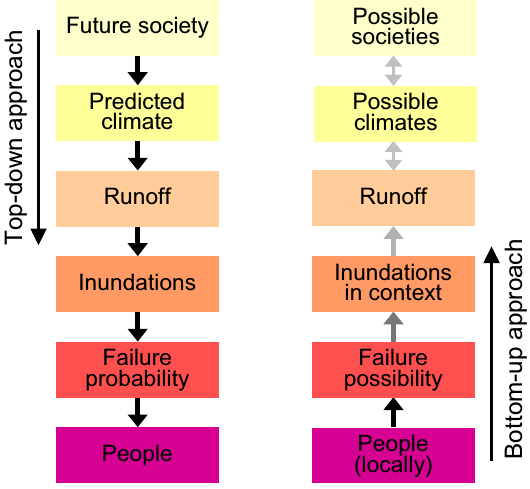
Figure 5. Left: traditional top-down approach to hydrological risk assessment based on climate projections. Right: bottom-up approach to hydrological risk assessment that is vulnerability or resilience centered. Approaches are illustrated by a fluvial lood risk example. Gray arrows indicate less dependence than black arrows. From Bloeschl et al. (2013)
By looking at the current challenges for people at the global level, I give high priority to the water-food-energy nexus, namely, the need for securing water, food and energy to future generations. Water, food and energy are intimately related and climate is a driver of this system. If we want to assign high priority to this system we need to look at it with more detail.
Water, energy and food are essential to human development for reasons that we all know very well. Food and water are essential for life; access to water is necessary for human sanitation. Water and energy are needed for producing and providing food. Energy needs to be produced in a sustainable manner and hydropower is a significant source of energy at the global level. Water and energy are difficult to store and move, while food can be transferred. The above - not exhaustive - examples clarify that there are numerous feedbacks among water, food, energy and humans. To emphasise suck links and retrofits the idea came forward of using a nexus approach, therefore defining the "water-food-energy nexus".
The idea of a nexus approach to water, energy and food security (WEF nexus) was first presented at the Conference "The Water, Energy and Food Security Nexus - Solutions for the Green Economy", held in Bonn during 16 – 18 November 2011 (see here the background paper of the conference by H. Hoff). A Nexus approach focuses on the complex and dynamic interrelationships between water, energy and food by looking at the impacts that a decision in one sector has on the full plurality of involved sectors. The nexus approach anticipates potential trade-offs and synergies, therefore allowing one to prioritise response options that are viable across different sectors. A nexus approach integrates management and governance across sectors and scales. A nexus approach can support the transition to different forms of economies which aims, among other things, at resource use efficiency and greater policy coherence. Given the increasing interconnectedness across sectors and in space and time, a reduction of negative economic, social and environmental externalities can increase overall resource use efficiency, provide additional benefits and secure the human rights to water and food. The nexus approach focuses on environment, economy and stakeholder dialogue (see Figure 6).
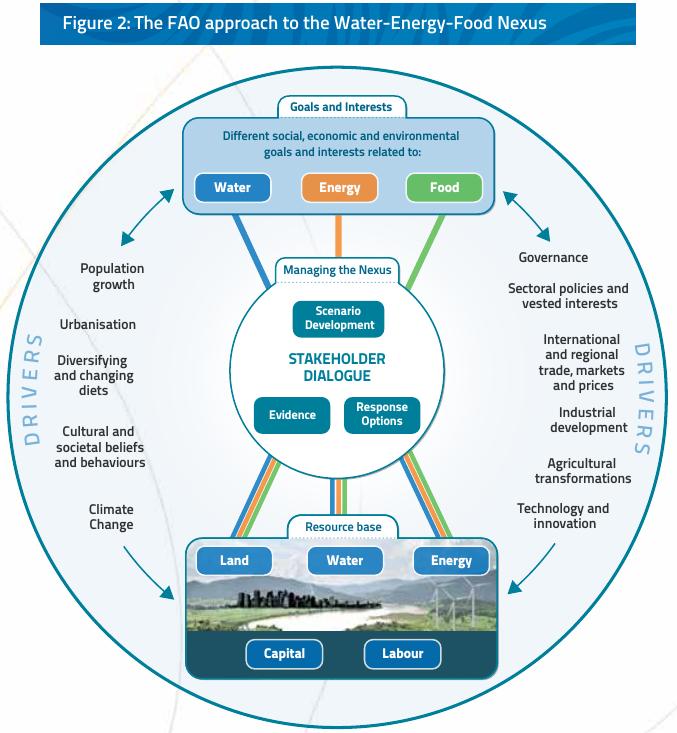
Figure 6. The FAO approach to the water-food-energy nexus (from The Water-Energy-Food Nexus - A new approach in support of food security and sustainable agriculture, Food and Agriculture Organization of the United Nations Rome, 2014, retrieved from http://www.fao.org/3/a-bl496e.pdf).
For the reasons outlined above, the WEF nexus is extremely relevant to sustainable development. We present here below some figures related to sustainability of the uses of water, energy and food.
Energy development is the field of activities focused on obtaining energy from natural resources. These activities include production of conventional, alternative and renewable sources of energy, and the recovery and reuse of energy that would otherwise be wasted. Energy should not be confused with electrical energy. Energy is defined in physics as the quantitative property that must be transferred to an object in order to perform work on, or to heat, the object itself. Electrical energy is derived from electric potential energy.
Energy resources may be classified as primary resources, suitable for end use without conversion to another form, or secondary resources, where the usable form of energy required substantial conversion from a primary source. Examples of primary energy resources are wind power, solar power, wood fuel, fossil fuels such as coal, oil and natural gas, and uranium. Secondary resources are those such as electricity, hydrogen, or other synthetic fuels.
Another classification that is relevant to sustainable development subdivides energy into two categories: "renewable" resources are those that recover their capacity in a time that is compatible with human needs. Examples are hydroelectric power or wind power. Non-renewable resources are those that are significantly depleted by human usage and that will not recover their potential significantly during human lifetime. An example of a non-renewable energy source is coal.
Acording to 2012 data, about 16% of global final energy consumption comes from renewable resources, with 10% of all energy from traditional biomass, mainly used for heating, and 3.4% from hydroelectricity. New renewables (small hydro, modern biomass, wind, solar, geothermal, and biofuels) account for another 3% and are growing rapidly. At the national level, at least 30 nations around the world already have renewable energy contributing more than 20% of energy supply. National renewable energy markets are projected to continue to grow strongly in the future. Wind power, for example, is growing at the rate of 30% annually, with a worldwide installed capacity of 282,482 megawatts (MW) at the end of 2012.
Renewable energy resources exist over wide geographical areas, in contrast to other energy sources, which are concentrated in a limited number of countries. Figure 7 shows the total world energy consumption by source, which shows that renewables are still a limited portion of energy production.

Figure 7. Total world energy consumption by source in 2012. By Delphi234 - Own work, CC0, https://commons.wikimedia.org/w/index.php?curid=20033816
Figure 8 shows the total energy production by countries, highlighting a still heterogeneous distribution.
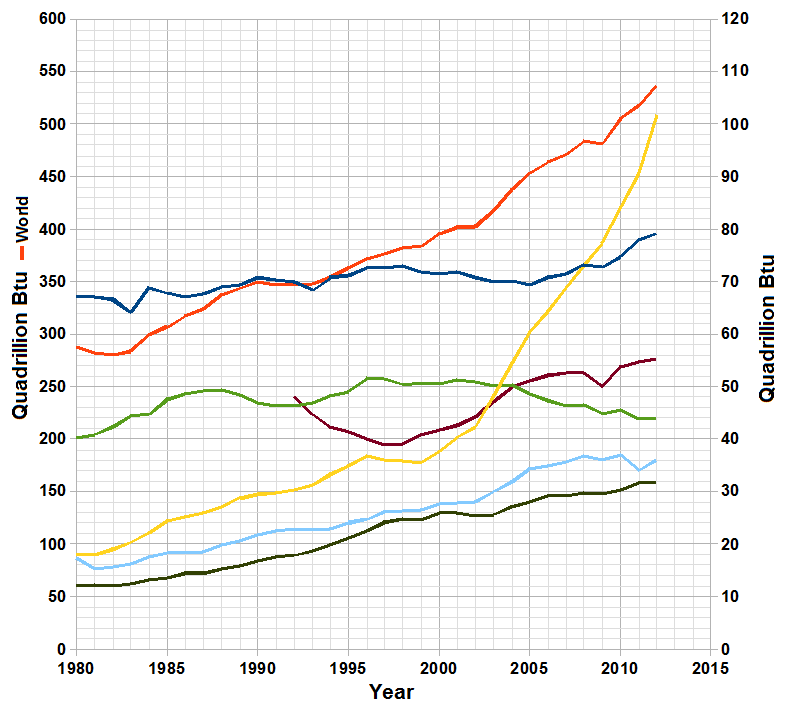
Figure 8. Total energy production by countries. The left vertical axis refers to the whole world, while the right vertical axis refers to the individual countries. Yellow is China; brown is Russia; light blue is Africa; blue is United States; green is Europe; dark green is Central and South America. By Delphi234 - U.S. Energy Information Administration (EIA)website eia.gov, Public Domain, https://commons.wikimedia.org/w/index.php?curid=36175030
The above Figure 7 shows that only about 0.7% of the total energy consumption is covered by wind turbines and solar panels. About 3.3% is covered by hydropower (data from 2012). In 2015 hydropower generated 16.6% of the world's total electricity and 70% of all renewable electricity (see "Renewables 2016: Global Status Report") and is expected to increase about 3.1% each year for the next 25 years. One can see that hydropower is still the most relevant renewable energy source after biomass heat and prevails dramatically over the others. Furthermore, the turn around time of hydropower is much shorter of that of biomass and hydropower may be easily stored in reservoirs, and reused through pumping, therefore providing an effective means to store energy.
Hydropower still plays a relevant role in the context of sustainability, through engineering and hydrology. This consideration is extremely relevant when discussing about transition to a green economy, as well as climate change mitigation and adaptation.
Today there is increasing interest in the target of using 100% renewable energy for electricity, heating/cooling and transport. Even if renewable energy use has grown much faster than anticipated, the feasibility of such a project in the short term is still debated.
Sustainability of water resources is a topical issue today in view of the increasing occurrence of water scarcity, which is defined as the lack of sufficient available fresh water resources to meet water demand. Water scarcity was listed in 2015 by the World Economic Forum as the largest global risk in terms of potential impact in the near future.
In the context of water resources management, sustainability can be defined as the property of water resources systems to remain functional in the long term. Note that the definition refers to the global plurality of water resources systems, and therefore not only at their local function. In fact, water resources are sometimes mismanaged because water is considered a local good and water issues are often treated as local problems. The reason is that water management is often planned at the local level, because water in itself is difficult to move far from its location. Therefore, one essential premise for sustainable water resources management is the adoption of a global perspective, which should necessarily lead to a global water policy by taking into account the opportunities offered by virtual water transfer, which is discussed below. Science is moving forward along this direction by promoting global modeling and global assessment of water resources.
Of course local management remains the fundamental piece to build the whole puzzle, but each of these pieces needs to be placed in the right position within coherently shaped global picture. To reach the target, it is necessary that local design takes into account:
- Water resources assessment;
- Lifetime of the water resources system;
- Societal development during the lifetime of the system;
- Changes in water resources status during the lifetime of the system, which may be due to local anthropogenic impact and climate change;
- Resilience of the system to societal development and changes in water resources;
- Afterlife of the system, including opportunities for recovery and renovation;
- Interaction with governance at local, regional and global scale.
The first two items are traditionally explored by hydrologists and water resources engineers, with consolidated methods that are still valid in the presence of change and increasing societal development. However, we should note that the interdependencies and feedbacks between the different hydrological cycle components and society are often not fully appreciated. It is increasingly clear that hydrology and humans are connected through a two-ways interaction whose feedbacks and the related uncertainties need to be taken into account. However, we often do not have enough data for design and therefore research questions arise about the estimation of design variables in absence of sufficient data resources. Also, water quality monitoring programmes are inadequate or lacking in several nations; despite two decades of increased international scientific attention and concern, attempts to collect, compile and gain knowledge from water consumption, pollution and abstraction data and information at a global scale are still not satisfactory, although we do see relevant progresses, mainly due to new monitoring technologies.
The last item is the key for making an efficient and optimal design successful. Connection with governance and the public is essential for a proper use of water resources, which in turn requires "social learning". The latter is an essential element of policy development and implementation, that is supposed to enable us to to develop a timely and adequate response to the changing dynamics of social–hydrological systems in concrete contexts of action. When turning to the practical implementation of measures, we often experience the challenge that the governance and social systems do not respond as expected, for several reasons ranging from political conflict, insufficient economic resources, inefficiency of administration and so forth. The problem has been recently exacerbated after the introduction of participatory approaches in water resources management, and the widespread dissemination of information and knowledge. In fact, we still lack objective methods for developing a synthesis of different and diverging opinions. Scenario analysis, that is, the process of analyzing possible future events by considering alternative possible outcomes, helps in assessing the likely outcome from different policy alternatives, but still its use is often not convincing in view of its uncertainty and the frequently skeptical attitude of stakeholders.
Social learning entails developing relational capacities to learn how to collaborate and understand others’ roles and capacity, by taking into account institutional arrangements and the social context. Therefore, the problem lies in developing new identities, as well as institutions and individual capacities, that are more socially and ecologically robust with the common goal of sustainability. The interdisciplinary collaboration between geoscience and social science is essential in this respect, where each discipline should assume the role that is pertinent to its background and knowledge. The connection between engineering and society necessarily needs to be supported by social and political sciences.
Societal development and change are driving forces that, when combined with the pressures from economic growth and major population change, make the sustainable development of water resources a challenge. The combination of these drivers usually results in increased water use, competition and pollution in addition to inefficient water supply. These results can be traced back to local and short-term decisions in water resources management that lack the global and long-term vision needed to implement sustainable development.
The role of research and education is much relevant in this context. Change in hydrology and society is the subject of the international research decade 2013-2022 "Panta Rhei", promoted by the International Association of Hydrological Sciences, which is currently organizing a global effort to stimulate research about sustainable water resources management.
An interesting opportunity that has been recently proposed to manage water resources at the global level and to move water is given by the virtual water transfer. Virtual water trade (also known as trade in embedded or embodied water) refers to the hidden flow of water if food or other commodities are traded from one place to another. The concept of virtual water was introduced by John Anthony Allan (King’s College London and the School of Oriental and African Studies) to support his argument that countries in the Middle East can save their scarce water resources by relying more on import of food. The key concept to assess virtual water trade is that of water footprint, which is defined as the total volume of fresh water used to produce the goods and services consumed by individuals or communities. Figure 9 shows the global water footprint for each country.
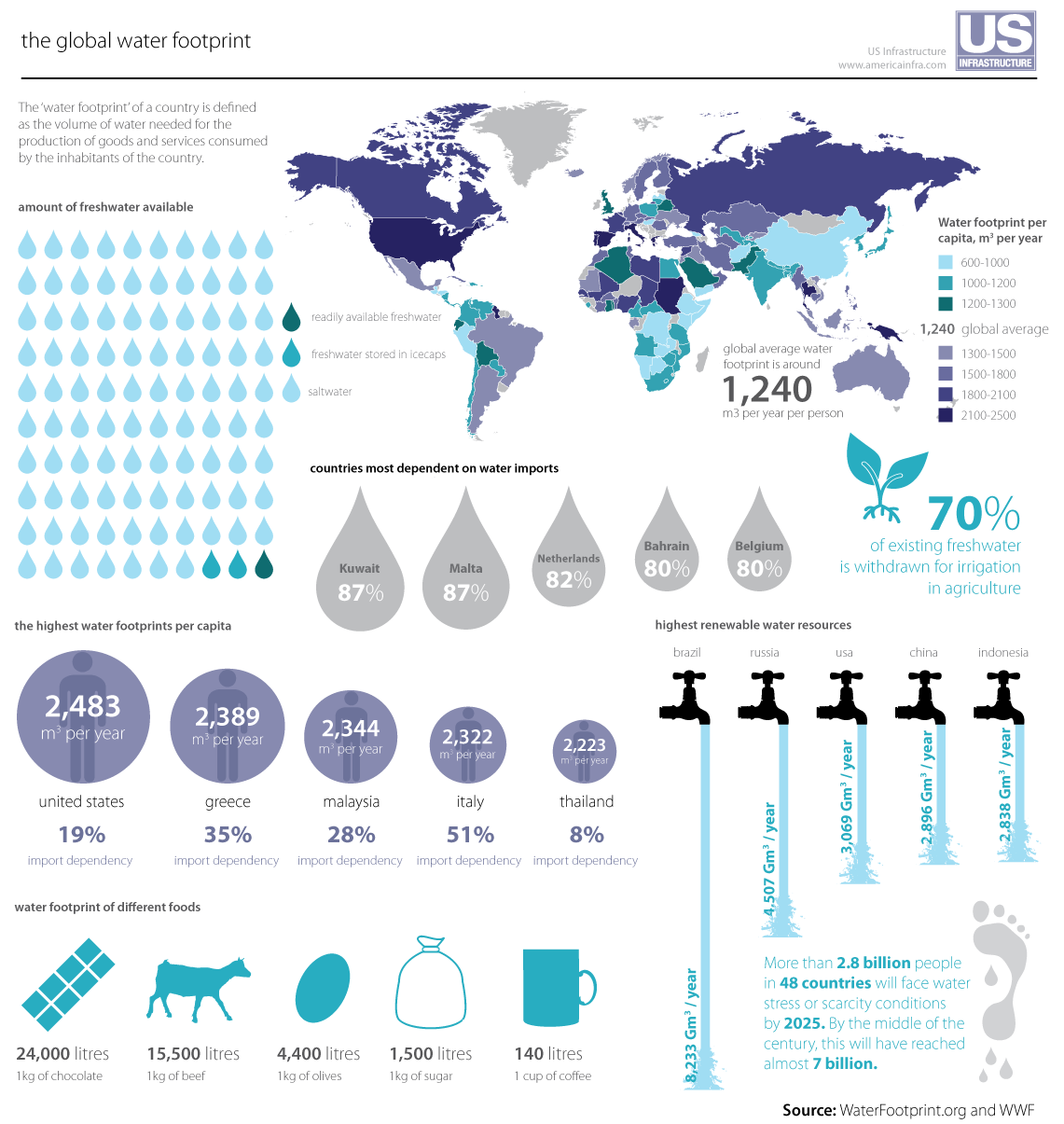
Figure 9. The 'water footprint' of a country is defined as the volume of water needed for the production of goods and services consumed by the inhabitants of the country. By Tiffany Farrant - https://www.flickr.com/photos/gdsdigital/4306320940/, CC BY 2.0, https://commons.wikimedia.org/w/index.php?curid=72143043
Water flow, for the purposes of water resources management, is classified as "blue", "green" and "grey" water flow.
- The blue water footprint is the volume of water that has been sourced from surface or groundwater resources (lakes, rivers, wetlands and aquifers) and has either evaporated (for example while irrigating crops), incorporated into a product or taken from one body of water and returned to another, or returned at a different time. Irrigated agriculture, industry and domestic water use can each have a blue water footprint.
- The green water footprint is the amount of water from precipitation that, after having been stored in the root zone of the soil (green water), is either lost by evapotranspiration or incorporated by plants. It is particularly relevant for agricultural, horticultural and forestry products.
- The grey water footprint is the volume of water that is required to dilute pollutants (industrial discharges, seepage from tailing ponds at mining operations, untreated municipal wastewater, or nonpoint source pollution such as agricultural runoff or urban runoff) to such an extent that the quality of the water meets agreed water quality standards.
Figure 10 shows a global picture of total, blue, green and grey water footprint for each country.
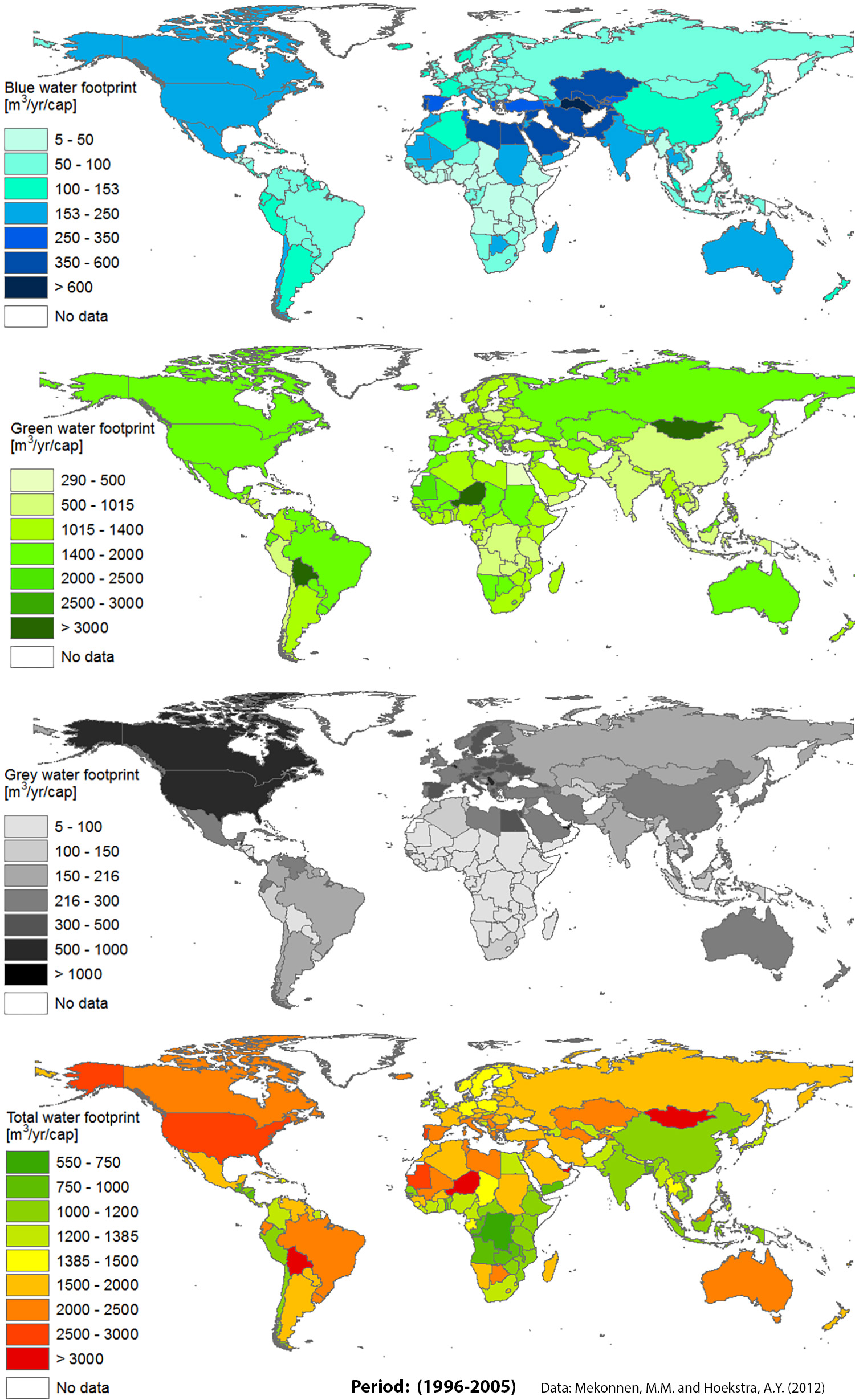
Figure 10. Global view of national per capita water footprints. By Sampa - Own work, CC BY-SA 4.0, https://commons.wikimedia.org/w/index.php?curid=67203940
Figure 11 shows the subdivision between internal and external water footprint at the global level.
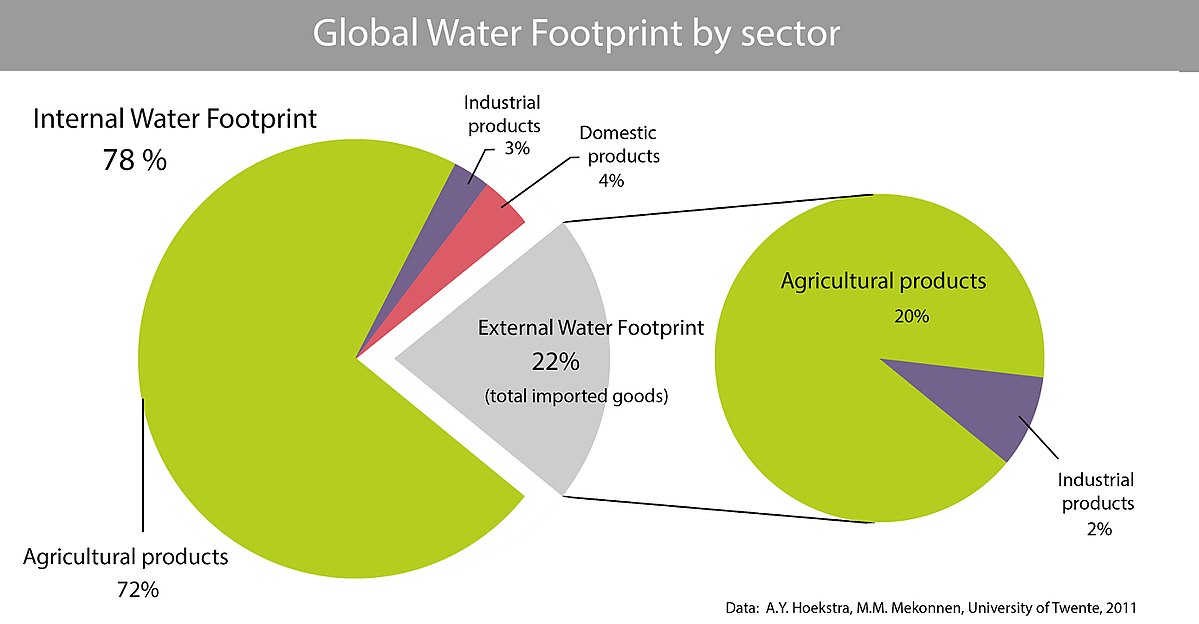 Figure 11. Global average numbers and composition of all national water footprints, internal and external. By Sampa - Own work, CC BY-SA 4.0, https://commons.wikimedia.org/w/index.php?curid=66838584
Figure 11. Global average numbers and composition of all national water footprints, internal and external. By Sampa - Own work, CC BY-SA 4.0, https://commons.wikimedia.org/w/index.php?curid=66838584
While the concept of water footprint and virtual water trade provide interesting opportunities for global planning, there are significant difficulties associated with the possible use of the concept for policy making. In fact:
- The concept relies on the assumption that all sources of water, whether in the form of rainfall or provided through an irrigation system, are of equal value.
- It implicitly assumes that water that would be released by reducing a high water use activity would necessarily be available for use in a less water-intensive activity. This may not be the case, nor might the alternatives be economic.
- It fails as an indicator of environmental harm nor does it provide any indication of whether water resources are being used within sustainable extraction limits. The use of virtual water estimates therefore offer no guidance for policy makers seeking to ensure that environmental objectives are being met.
The deficiencies with the concept of virtual water mean that there is a significant risk in relying on these measures to guide policy conclusions. Accordingly, policy makers are sometimes skeptical on its value to support sustainability. Again, the concept of virtual water trade is to be framed within the context of engineering, to translate its indications and limitations into technical guidance.
Sustainability is strictly related to climate change. In fact, climate is a fundamental driver of water resources availability, energy and food production. Changes in climate may undermine the functioning of water resources and energy systems and therefore may undermine the sustainability of human development.
Climate is subjected to natural and human induced variability. Natural climate variability refers to the variation in climate caused by nonhuman forces. Human induced variability may be observed at local and global scale. At the global scale, it may be caused by the global increase in CO2 concentration in the atmosphere, which in turn may be due to increased human emissions.
It is not yet clear how natural and human induced variability interact to determine the changes in climate that were recently observed. The climate system is characterised by high complexity and is subjected to the chaos, which translates into lack of predictability. It is well known that climate underwent significant changes in the past that were caused by non-human forces and therefore it is difficult to predict to what extent global warming will behave in the future. Furthermore, while the effects of climate change are clear for what refers to temperature, we still have a limited understanding of how it may affect other climatic and meteorological variables, like for instance extreme rainfall. The predictions (which are frequently called "projections") given by climate models are useful for scenario analysis, but provide limited support to engineering design.
Climate change has recently assumed a high political relevance for the widespread diffusion of climate alarmism, based on the prediction that the climate system will shortly cross a tipping point if immediate action is not taken to reduce CO2 emission. Alarmism shifted the priorities of researchers and politicians towards climate, while less attention is currently being devoted to water resources, energy and sustainability in general. While sustainable development is certainly and strictly related to climate change, alarmism is fueling unconstructive scientific controversy and therefore it is not supporting the identification of proper solutions.
It is urgently needed that scientific consensus is built around climate change. Instead of arguing what scientists disagree on, it would be advisable to focus on agreed conclusions in terms of sustainability.
Climate change will be further discusses in a subsequent lecture.
Download the powerpoint presentation of this lecture
Last updated on January 15, 2019
- 1409 views
